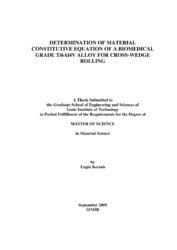Please use this identifier to cite or link to this item:
https://hdl.handle.net/11147/3017Full metadata record
| DC Field | Value | Language |
|---|---|---|
| dc.contributor.advisor | Güden, Mustafa | en |
| dc.contributor.author | Kıranlı, Engin | - |
| dc.date.accessioned | 2014-07-22T13:50:43Z | - |
| dc.date.available | 2014-07-22T13:50:43Z | - |
| dc.date.issued | 2009 | en |
| dc.identifier.uri | http://hdl.handle.net/11147/3017 | - |
| dc.description | Thesis (Master)--Izmir Institute of Technology, Materials Science and Engineering, Izmir, 2009 | en |
| dc.description | Includes bibliographical references (leaves: 73-76) | en |
| dc.description | Text in English; Abstract: Turkish and English | en |
| dc.description | xi, 76 leaves | en |
| dc.description.abstract | In the present work, the JC flow stress and damage parameters of a biomedical grade Ti6Al4V alloy that contained very low levels of interstitial elements were determined for the modeling its deformation in the CWR process. The JC models were determined through quasi-static (10-3-0.1 s-1) and high strain rates (300-1000 s-1) within the temperature range of 25-1150 oC. High strain rate tests were performed using both compression and tension SHPB testing devices. The damage model was determined using notched specimens of different stress triaxiality. The tested alloy flow stresses were found to increase with increasing strain rate for both compression and tension tests. This was proved that the alloy has a strain rate sensitive flow stress behavior. At increasing strain rates the failure strains in tension decreased. The reduced fracture strain was also confirmed by the microscopic observations. In statically tested samples the ductile fracture mode was composed of smaller but deeper dimples, while the dimples were observed to be shallow and larger in dynamically tested samples. The tensile fracture presumably started in a region and the b phase microscopically shown to deform plastically through the tensile axis. The compression failure mode of the alloy was found to be resulting from the shear band formation followed by the fracture of the shear band. High temperature test conducted at quasi-static strain rate showed that the stress values decreased greatly after about 800 oC due to a ->b transformation. Due to this two different JC material models valid between 25-600 oC and 800-1150 oC were developed. The determined JC parameters were found to be well agreed with the literature except the model obtained from the compression tests. | en |
| dc.language.iso | en | en_US |
| dc.publisher | Izmir Institute of Technology | en |
| dc.rights | info:eu-repo/semantics/openAccess | en_US |
| dc.subject.lcc | R857.M3 .K89 2009 | en |
| dc.subject.lcsh | Biomedical materials | en |
| dc.subject.lcsh | Titanium-aluminum-vanadium alloys | en |
| dc.title | Determination of material constitutive equation of a biomedical grade Ti6AI4V alloy for cross-wedge rolling | en_US |
| dc.type | Master Thesis | en_US |
| dc.institutionauthor | Kıranlı, Engin | - |
| dc.department | Thesis (Master)--İzmir Institute of Technology, Materials Science and Engineering | en_US |
| dc.relation.publicationcategory | Tez | en_US |
| item.fulltext | With Fulltext | - |
| item.grantfulltext | open | - |
| item.openairetype | Master Thesis | - |
| item.openairecristype | http://purl.org/coar/resource_type/c_18cf | - |
| item.languageiso639-1 | en | - |
| item.cerifentitytype | Publications | - |
| Appears in Collections: | Master Degree / Yüksek Lisans Tezleri | |
Files in This Item:
| File | Description | Size | Format | |
|---|---|---|---|---|
| T000174.pdf | MasterThesis | 5.85 MB | Adobe PDF |  View/Open |
CORE Recommender
Items in GCRIS Repository are protected by copyright, with all rights reserved, unless otherwise indicated.